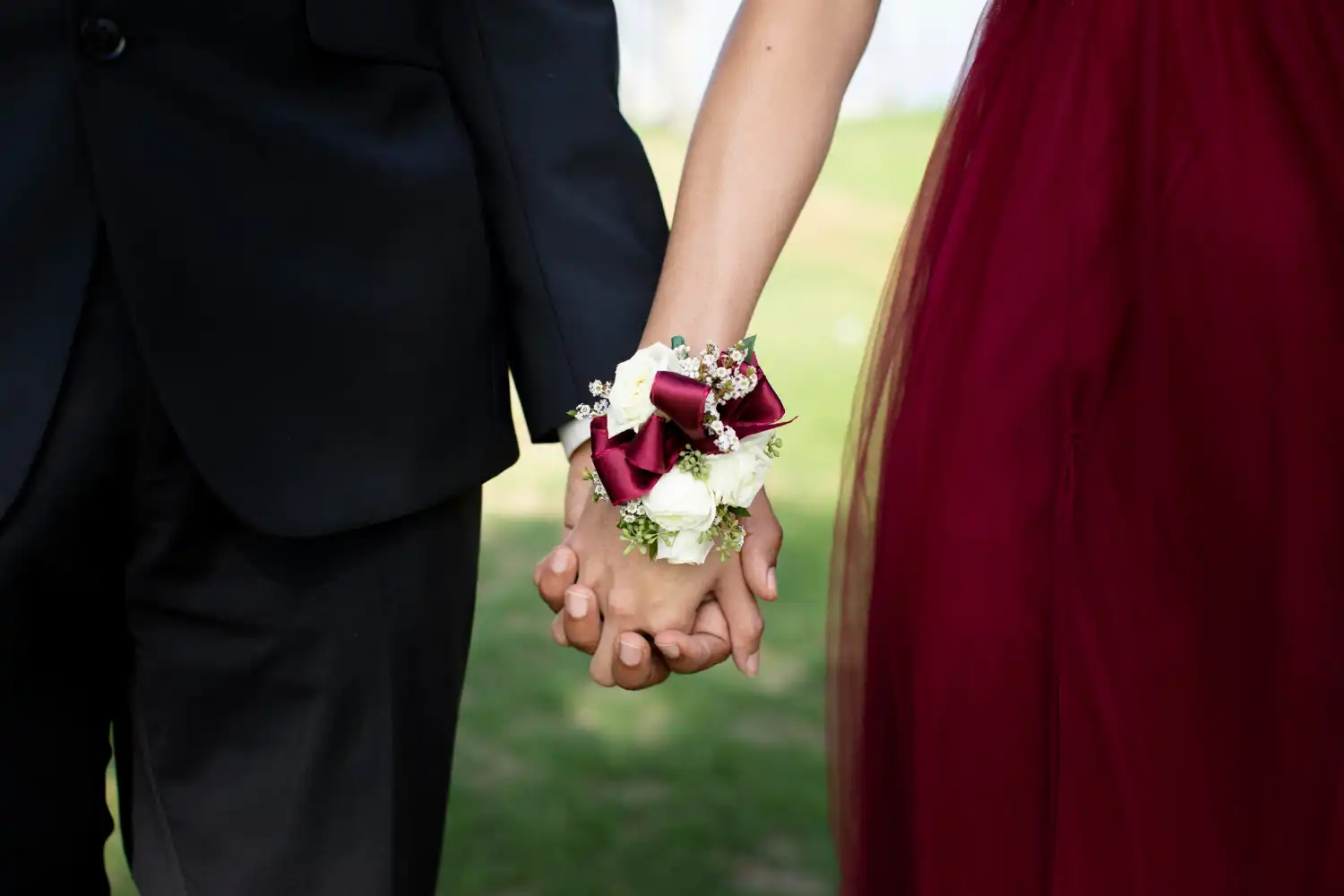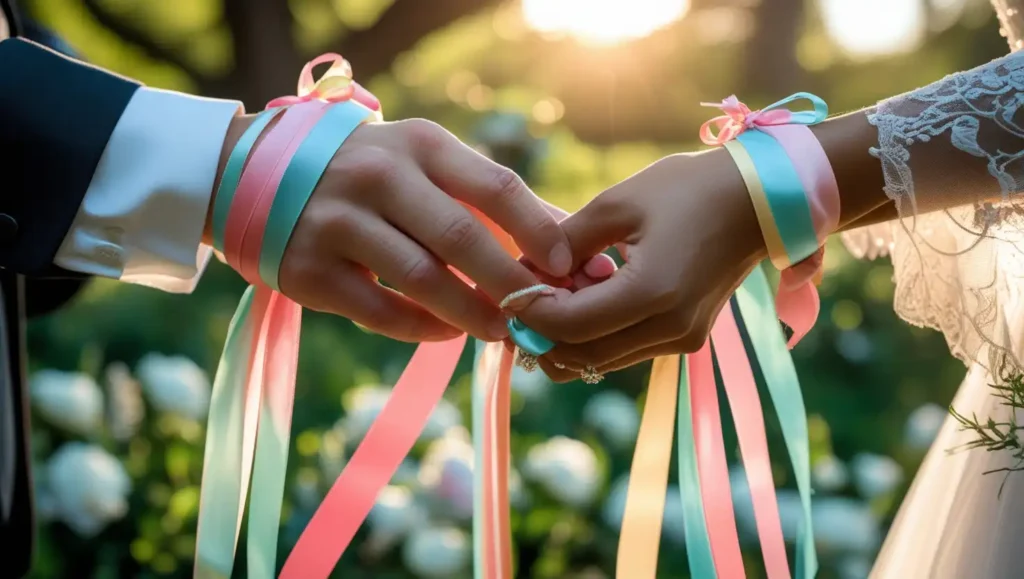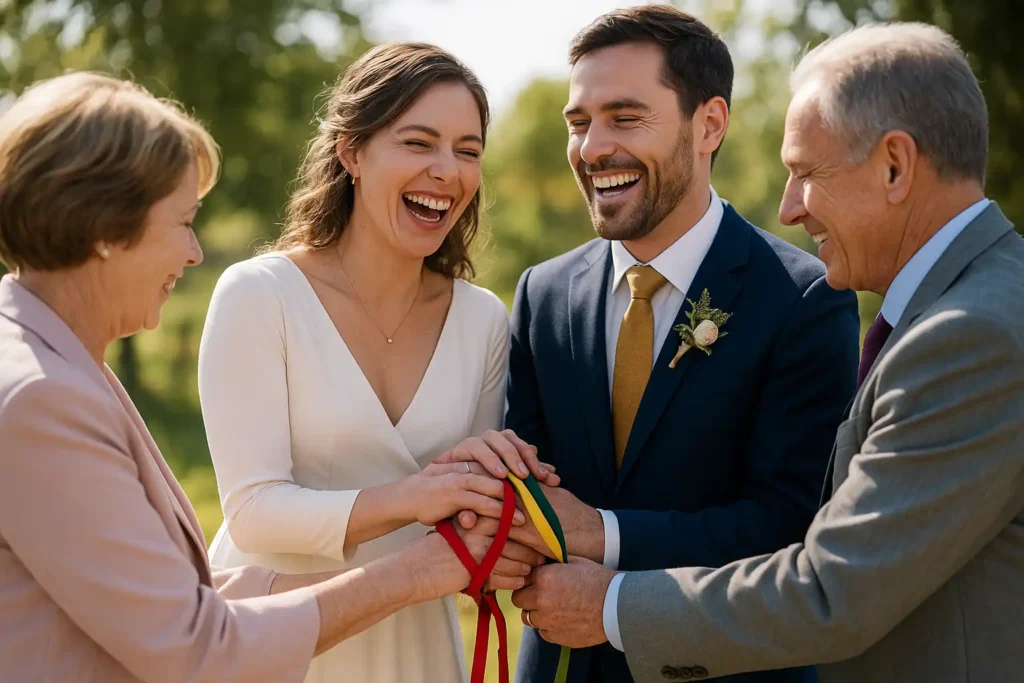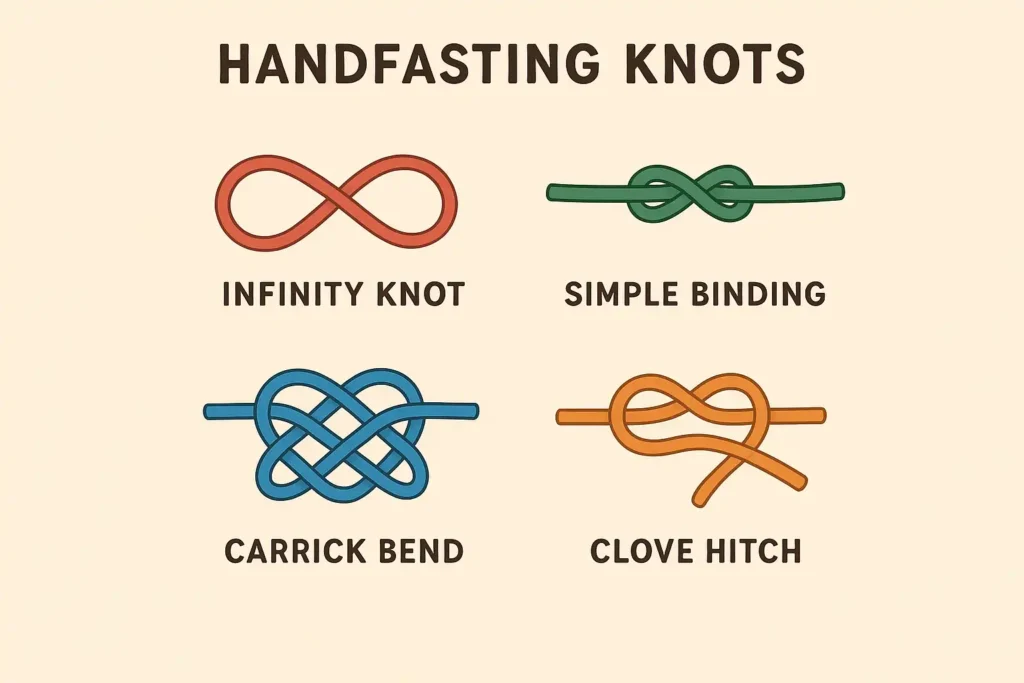Email: [email protected]
Phone: +44 7710 621141

Curious about the handfasting ceremony? Dive into our complete guide on this beautiful, ancient wedding ritual. Learn its history, meaning, and how to create your own.
A handfasting ceremony may seem to be something out of a fairy tale (or fantasy novel), but this poignant wedding ritual is becoming increasingly popular. Have you ever wondered where the phrase “tying the knot” comes from? This is not just an expression — it comes from this practice. For couples wanting a wedding ceremony that is more personal and more deeply symbolic than a simple exchange of rings, handfasting creates a lovely option.
Consider this the “everything you want to know” guide for the ancient custom of handfasting, including its origins and rich history, and plan on incorporating this into your special day.

What is a handfasting ceremony? Handfasting, at its core, is a unity ritual where the couple’s hands are tied together with cords or ribbons to symbolize their union. This physical binding signifies two lives becoming one. It’s a powerful visual representation that remains even after the couple and officiant remove the ribbons.
Handfasting is often featured in pagan, modern, and Wiccan ceremonies; however, it has also become popular in secular, spiritual, and various non-traditional weddings. People from all backgrounds are drawn to the ancient tradition of handfasting, along with the meaning and richness of its symbolism.
The ritual goes back thousands of years and has ancient, historical roots. It is best known as it relates to the ancient Celts in Ireland and Scotland. Then, it was more than a symbolic gesture, but was considered a formal betrothal or marriage contract. A Druid priest, or the local village elder, would tie one’s hands to the other’s hands, normally during a festival like Beltane, to officiate a handfasting ceremony in front of the community.
It is said that the creation of the word handfasting itself comes from an Old Norse word, hand-festa, which means “to bargain by joining hands.”
One of the most fascinating parts of handfasting history is the idea of a “trial marriage.” In some traditions, particularly during the Middle Ages, a handfasting wasn’t for life—at first. It was a commitment that lasted for “a year and a day.”
During this time, the couple would live together and see if they were truly compatible. At the end of the year, they could choose to make the union permanent or part ways without any social stigma. This practical approach recognized that love and partnership are a journey, not just a single moment in time.
Bringing this ancient ritual into your modern wedding is surprisingly simple and incredibly personal. The beauty of a handfasting ceremony is its flexibility; you can adapt it to match your style and story perfectly. A celebrant often performs it, but you can also involve family members to make it even more special.
The ceremony usually takes place before or during the exchange of vows and rings. The officiant will start by explaining the meaning of handfasting to your guests. Then, you and your partner will join hands, and the wrapping begins.

The cords are the central element of the handfasting. You aren’t limited to just one; many couples use three or more cords braided together, or have different people wrap a single cord for each vow. The material can be anything meaningful to you—ribbons, lace, strips of tartan from your clan, or even a piece of fabric from a family heirloom.
The colors you choose for your handfasting cords can add another layer of beautiful symbolism to your ceremony. While you can pick any colors that feel right for you, certain colors have traditional meanings that can help tell your love story.
| Color | Meaning |
| Red | Passion, strength, love, courage |
| White | Purity, truth, peace, new beginnings |
| Blue | Loyalty, trust, patience, tranquility |
| Green | Growth, luck, prosperity, connection to nature |
| Yellow | Joy, happiness, confidence, balance |
| Purple | Spirituality, wisdom, power |
| Gold | Unity, longevity, prosperity, success |
| Pink | Love, romance, unity, honor |
Don’t feel like you have to stick to just one! Mixing colors can create a cord that truly represents the different facets of your relationship—like combining red for passion with white for purity.
There’s no single right way to tie the cords. Your officiant might wrap them around your hands while you recite your vows. A popular method is to have the couple clasp hands, right to right and left to left, creating an infinity symbol shape. As the cords are wrapped, blessings or vows are spoken.
At the end of the ritual, the couple can either slip their hands out, leaving the knot intact, or be gently unwrapped. The tied cord becomes a wonderful keepsake of the promises you made. This is, quite literally, your “knot” that you’ve tied together.
Handfasting provides a perfect moment for heartfelt vows. You can exchange vows while the cords are being wrapped, with each ribbon representing a different promise. The vows can be simple or elaborate, but they should come from the heart.
Here’s a small example to inspire you:
“With this cord, I promise to walk beside you. With this cord, I promise to support your dreams. With this cord, I bind my heart to yours, today and for all my days.”
A handfasting ceremony is a beautiful opportunity to do something different and to provide your guests with a ceremony that is personally meaningful and memorable.
A handfasting ceremony is more than two people getting married; it symbolizes two equals choosing to join their lives. The binding of the hands metaphorically symbolizes unity and shared strength. The binding of hands also represents the joining of two distinct paths into a united future.
Your wedding should be a reflection of you. A handfasting ceremony is incredibly easy to customize. You choose the colors, the materials, the words, and who participates. This ritual allows you to embed your own story, values, and cultural heritage directly into the heart of your ceremony.
Do you and your partner love nature? Use earthy green and brown cords. Are you blending families? Have your children each bring forward a ribbon to add to the knot.
Wedding vows are beautiful, but they are words spoken into the air. A handfasting ceremony creates a physical object—a tangible representation of your promises. The knotted cord can be kept and displayed in your home as a constant reminder of the day you bound your lives and hearts together. It’s a powerful memento from a day filled with love.
Handfasting is more than a historical reenactment; it’s a living tradition that couples are continuing to shape and redefine.
While the ritual has strong Pagan and Celtic roots, its core message of unity is universal. People from all backgrounds can appreciate the symbolism of joining hands and lives. You don’t have to follow any specific faith to feel the power of this symbolic act. It has become a popular choice in humanist and secular ceremonies as well.
One of the most touching ways to personalize a handfasting is to involve your family and friends. Imagine your parents each laying a cord over your hands, giving their blessing. Or you could have members of your wedding party each present a ribbon that represents a wish for your future, such as happiness, health, or prosperity.
This turns the ceremony from something you witness to something your whole community helps create.

After the wedding, what do you do with the cord? Many couples frame it in a shadow box, sometimes along with their vows or a photo from the ceremony. Others place it on a special altar in their home. Some have even said they plan to give a piece of their cord to their children to use in their own handfasting ceremonies someday. It’s a living piece of your history.
Handfasting ceremony is a gorgeous, timeless ritual that allows couples to celebrate the union between them in a way that is both very old and completely new. It is all about the symbolism of marriage: bringing your lives together, supporting one another, and creating a collective future together. All tied up in a beautiful, symbolic knot.
If you’re looking to have an engaging, meaningful, and outwardly stunning ceremony, then “tying the knot” may just be the best way for you to start your married life together.
What do you think of this ancient tradition? Could you envision having a handfasting ceremony as part of your very own wedding ceremony? Let us know your thoughts in the comments below!
Want to read the blog on flowers for your wedding dress? Check out the Top 10 Flowers for Your Wedding Dress
No, a handfasting ceremony is purely symbolic and is not a legally binding marriage contract in most places today. You will still need to complete the legal paperwork required in your country or state to be legally married.
A wedding celebrant is the most common choice, especially one experienced in unity rituals. However, you can also ask a trusted friend or family member to lead the handfasting portion of your ceremony, making it even more personal.
This is entirely up to you! Some couples keep their hands bound for the remainder of the ceremony, slipping them out just before the recessional. Others remove their hands right after the vows, pulling the ends of the cords to tighten the knot symbolically.
The phrase “tying the knot” is widely believed to have originated from the handfasting ceremony, where a knot is literally tied around the couple’s joined hands to symbolize their union.
Absolutely. Handfasting is a very adaptable ritual. It’s often included in Pagan and spiritual ceremonies. Still, it can be incorporated into secular and even some religious services as a unity ritual, similar to a unity candle or sand ceremony. The key is to discuss it with your officiant to see how it can best fit into your ceremony’s structure.
Join our weekly newsletter and get the latest wedding trends, expert planning tips, and elegant inspiration delivered straight to your inbox.
No spam, no fluff - just beautifully curated content for modern couples.